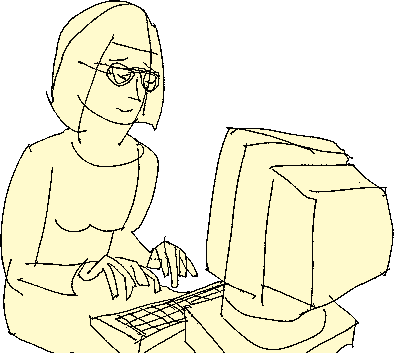 Here I am, on a new clinical rotation during my last
semester of nursing school, having
taken my patient's vitals, assessed her skin (she is
elderly, bed-bound, and at risk for bedsores),
tracked her Is and Os, straightened up her bed, and
it is time to do the charting before moving
on to my next patient. Some earlier
clinicals had been in pre-EHR
(electronic health record)
hospitals and I had appreciated the fine-tuned
process in which, with a few check-marks ("charting by
exception") and notating the changes (fortunately,
my patient's health was improving) I would
have been done with this task in a couple of minutes.
Here I am, on a new clinical rotation during my last
semester of nursing school, having
taken my patient's vitals, assessed her skin (she is
elderly, bed-bound, and at risk for bedsores),
tracked her Is and Os, straightened up her bed, and
it is time to do the charting before moving
on to my next patient. Some earlier
clinicals had been in pre-EHR
(electronic health record)
hospitals and I had appreciated the fine-tuned
process in which, with a few check-marks ("charting by
exception") and notating the changes (fortunately,
my patient's health was improving) I would
have been done with this task in a couple of minutes.
Times have changed. Obamacare and Meaningful Use have brought EHRs to nearly every American hospital. So here we go, let's enter our data. First, find a COW (computer on wheels) or WOW (workstation on wheels) as we've been instructed to call them, lest patients think we might be referring to them (who would call a patient a cow? That's silly! But so it is.)
And there it is, in the hallway right outside my patient's door. Hit the enter key to light up the screen and get to work... Nothing. Its last user forgot to plug it in and the battery's gone dead.
 Never mind, there's another, down at the end of the hall.
Blessedly, it's all charged up and ready to go.
Now, login: hmm, what's my password? I have so many
of them. Easy. It's on a Post-it stuck to the back
of the Student RN ID badge on my lanyard.
This violates hospital policy but everyone does it;
it's an essential workaround.
Never mind, there's another, down at the end of the hall.
Blessedly, it's all charged up and ready to go.
Now, login: hmm, what's my password? I have so many
of them. Easy. It's on a Post-it stuck to the back
of the Student RN ID badge on my lanyard.
This violates hospital policy but everyone does it;
it's an essential workaround.
I am using the WOW in the hallway. I could drag it into the patient's room but then I'd have that infamous "triad": the patient, the nurse, and the computer. It's hard to mouse and type while conversing and maintaining eye contact.
I log in, select my patient from a list, and drill down through layers of menus to the one in which I enter my patient's vitals. After a dozen clicks and dismissing various warnings (e.g. my patient's allergies have not yet been entered -- not my job, it should have been done at admission), I'm ready to get work done. Each vital sign has options I must reject in order to reach the Respiration Rate field where I can type "14". How did I remember that number? On another Post-It, of course. I keep them in my scrubs pocket and jot as I go, for later entry (as I'm doing now) into the EHR. Four minutes later, my charting is done. Not bad, though it did take two minutes more than it did in the bad ol' days of paper charts.
Now it's time to prepare for my next patient. I need a quick overview of his status. I return to the patient menu, select him, and drill down to his problem list. Which meds is he taking? That's another report and several more menu layers. Any precautions I must be aware of before I see him? More menus. I miss the Kardex.
Here's another clue: how many of us still carry that sheet of paper we call our "brain" in our scrubs pocket? I couldn't imagine life without the eMAR (electronic medication administration record) and bar codes. I scan my patient's wristband and the package of each "unit dose" medication while the computer confirms that I'm giving the right med in the right dose by the right route to the right patient at the right time (the "five rights") and I'm grateful for the automated confirmation. But I must not be lulled into blindly giving meds just because they were ordered; patient status can change quickly and my clinical judgment must ensure that each order still makes sense for this patient at this time. If my patient's blood pressure is low I may opt to withhold that ordered beta blocker. The computer can't do that. Indeed, computers are not always our friends.
 So where does this leave us? I grouse about
EHR charting; colleagues complain that they
spend more time at the computer than with patients.
(This drawing by a 7-year old shows the MD looking
at the computer not at her.)
So where does this leave us? I grouse about
EHR charting; colleagues complain that they
spend more time at the computer than with patients.
(This drawing by a 7-year old shows the MD looking
at the computer not at her.)
Yet, on balance, technology is improving the quality of care. Some problems have gone away. Remember when we lugged those brick-heavy drug tomes? Now we look drugs up with our phones.
Remember the hassles of the endless, "Where has my patient's chart gone?" days? We often had to hunt around for it. Now it's anywhere there's a COW or a WOW or a PC in the nursing station.
Better yet, let's put it in every nurse's hand, on a smartphone or mini-tablet in the scrubs pocket. No more Post-Its; we can save our findings right there, on the spot, in the patient's room or as we walk down the hall to our next assignment.
I am working on this. I am building smartphone apps that fit nursing workflow. In my previous career, I was a computer programmer. Seeing nursing through my programmer's eyes, it is clear to me that engineering for nursing workflow is still in its infancy. In our daily work, we use EHRs, staffing planners, secure messaging, and all those clinical devices that beep and squawk and sound alarms. When I'm looking at a computer screen, I'm not looking at a patient; I've been pulled from my job's true focus. But this is changing.
Redesigning medical processes takes decades. I am optimistic that, with time, we will achieve this, and healthcare and nursing processes will, in the long run, be the better for it. And I am building the tools that will get us there.
-- Dan Keller RN MS, 2010, updated 2020 and 2023